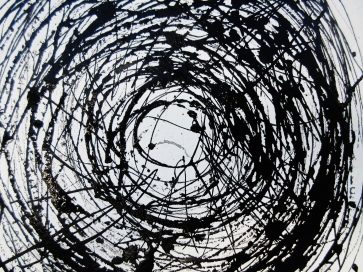Research Point page 101.
Contemporary Artists whose work involves the underlying structure of the body
Damien Hirst (born 1965)
Hirst is an English artist, collector and curator. He is one of the Young British Artists, who became famous in the 1990’s. He is known for organising and curating Freeze exhibition in a disused warehouse for his fellow Goldsmith students. Hirst is one of the richest living artists today.
I chose Damien Hirst to study as I saw his exhibition at Houghton Hall, Norfolk, this year. I was impressed with his large sculptures that incorporate the human body. I know Hirst explores themes mainly to do with death. Hence his famous series of dead animals in formaldehyde. However I really like his painted bronze sculpture of ‘Sensation’ 2003, it looks like a slice of cake, but is in fact a section through the skin. In comparison the over sized sculpture of ‘The Virgin Mary’ (2005-2006) set in the ground of Houghton Hall is quite magnificent, it’s of a pregnant woman with the right side flesh peeled back to expose muscles, bone and baby. ‘Anatomy of an Angel’, 2008 is a beautiful white marble statue of a female angel with half her body exposed to show the form underneath the skin. ‘Death and Glory’2001 in The Cabinet’ displays a skull and eyes divided between glass sheets. His ‘Saint Bartholomew, Exquisite Pain (2006) is a bronze figure with a pair of scissors in one hand and over an arm the flesh of a body on the table are some mathematical instruments.
Looking at Hirst’s work, you see that he uses a wide variety of materials to make his work, (well we know he employs others to carry out his ideas) and that’s what I found interesting about the exhibition at Houghton Hall, the large sculptures were set in the grounds and did have a sense of dominance and grandeur. As you were made to ‘look up’ at them I felt quite small myself, knowing some of these sculptures, like ‘Hymn’ and ‘Temple’ (2008) were inspired by the Humbrol anatomy toys which are in small size.
I have to mention Hirst’s most expensive piece of art, being, ‘For the Love of God’ (2007), modelled on a real human skull, was a platinum skull covered in 8,601 diamonds, costing £15,000,000. In November 2008, the skull was exhibited at the Rijksmuseum in Amsterdam next to an exhibition of paintings from the museum collection selected by Hirst. Wim Pijbes, the museum director, said of the exhibition, “It boosts our image. Of course, we do the Old Masters but we are not a ‘yesterday institution’. It’s for now. And Damien Hirst shows this in a very strong way”. https://en.wikipedia.org/wiki/Damien_Hirst
http://www.damienhirst.com/
https://www.houghtonhall.com/art-and-exhibitions/damien-hirst/
Jessica Burke Born in Wichita, Kansas, Jessica Burke is a figurative artist and educator living in southern Georgia.
Whilst researching I found this working artist in America. She has created, using the human skeleton a set of brightly coloured images, revealing and exposing their identity by ‘dressing’ them up as characters from t v and films. Her drawings are realistic and detailed, she uses Prismacolor, graphite, watercolour and oils. The collection of drawings explore, ‘the fiction of identity through its performance in physical and cerebral spaces that demonstrate a willingness to project and construct meaning. While these sentimental figures are absorbed with their own fantasy, they are still compelled to subvert conventional roles and relationships. They can acknowledge the absurdity of their circumstance by embracing the cultural detritus of the banal’.
https://www.jessicaburkeartist.com/pop-portraits/
Rene Magritte (1898-1967)
Rene Magritte a Belgian Surrealist artist, was famous for his witty and humorous work, with bowler hats and apples. In the 1960’s Magritte’s art influenced many contemporary artists we know today.
Magritte often portrayed the human form in his paintings. These forms were often morphed and placed in surreal backgrounds and settings. ‘Les Merveilles de la nature’, The Wonders of Nature, 1953, oil on canvas is a painting of fish humans with a sailing ship in the background, here Magritte has painted very realistic legs and torso with fish heads. At the age of 13, Magritte’s mother was drowned, her body was found with her nightdress over her head and she was naked from the waist down, even though Magritte denied that his work was influenced by this trauma, he still painted heads covered in scarves, female corpses in nightdresses, faces with missing parts and swirling waters. Magritte made bronze sculptures of face parts, eye, ears, lips and noses stacked up on each other. ‘The White Race’ (1967).
https://www.telegraph.co.uk/culture/art/8601525/Rene-Magritte-The-Pleasure-Principle-Tate-Liverpool-review.html
https://www.tate.org.uk/art/artists/rene-magritte-1553
https://en.wikipedia.org/wiki/Ren%C3%A9_Magritte
Leonardo da Vinci (1452-1519)
Leonardo is the most famous polymath artist, know for his painting of the ‘Mona Lisa’ and drawing of ‘Vitruvian Man’. Including his studies of Human Anatomy and sketches of animals.
‘As a successful artist, Leonardo was given permission to dissect human corpses at the Hospital of Santa Maria Nuova in Florence and later at hospitals in Milan and Rome. From 1510 to 1511 he collaborated in his studies with the doctor Marcantonio della Torre. Leonardo made over 240 detailed drawings and wrote about 13,000 words towards a treatise on anatomy’ https://en.wikipedia.org/wiki/Leonardo_da_Vinci#Scientific_studies

